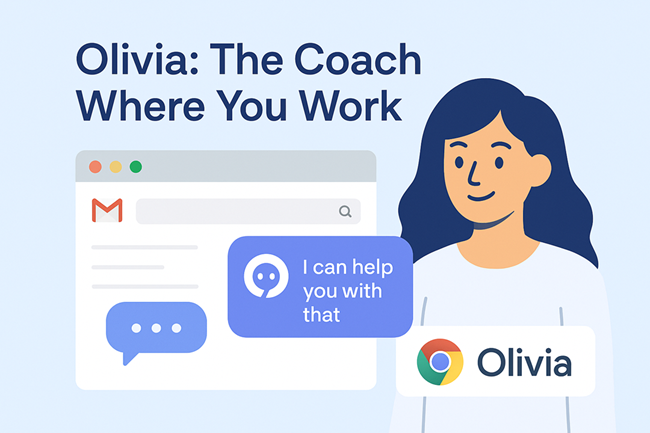Why Communication Tailored to Personality Matters and How AI Can Help
Good communication tailored to the person it’s being delivered to is the backbone of workplace success — from handling sensitive conversations to leading meetings with confidence.
Traditionally, employees have relied on human coaches for support. But with advances in AI, organizations now have a new option: AI-powered communication coaching, which uses the latest data science to provide highly tailored advice and support.
And AI coaching can reach far more people than face-to-face coaches ever could. Consider these figures from the International Coaching Federation:
- 109,000 accredited coaches worldwide
- 3.5 billion working adults globally
Even if each coach worked with 20 employees per month, they would reach just 2.18 million people — a tiny fraction of the global workforce.
So, how does an AI coach compare to a human coach? Let’s take a closer look at the pros and cons of AI coaching versus face-to-face coaching.
1. Availability
AI Coach : Always accessible, 24/7. Employees can ask questions and get advice, and prepare anytime — before a big meeting, during a late-night prep session, or even in real time in their email or other workspaces.
Human Coach : Usually requires booking sessions. Feedback may be delayed depending on schedules, which can reduce immediacy, especially in fast-moving situations.
2. Cost & Scalability
AI Coach : Affordable and scalable across an entire organization. Every employee can access the same level of support without breaking budgets.
Human Coach : Can offer rich interactions. But scaling up is expensive: more coaches, more time, more scheduling complexity.
3. Consistency of Feedback
AI Coach : Delivers tailored feedback that is based on their and their colleagues personalities. So every employee receives the same high standard of evaluation.
Human Coach : Can bring experience, nuance and adaptability. However, different coaches, styles or moods can lead to inconsistent feedback.
4. Speed of Feedback
AI Coach : Instant analysis on tone, clarity, pacing, and word choice. Employees can adjust on the spot.
Human Coach : Feedback is often scheduled; discussions happen in sessions. Thus, sometimes feedback arrives after the moment where it may have been most helpful.
5. Comfort & Privacy
AI Coach : Employees can practice sensitive conversations in a private, judgment-free environment. This often encourages more honest practice.
Human Coach : Can offer empathy, deep listening, and tailored emotional support. But some people may feel more inhibited with another person, especially early on.
6. Tracking & Analytics
AI Coach : Provides data dashboards and measurable progress tracking. Managers and employees can see clear improvements in engagement and resultant productivity over time.
Human Coach : Highly qualitative feedback; deep personal insight that is hard to turn into metrics.
7. Language Support
AI Coach : Offers multi-language support and real-time translation, making it inclusive for global teams.
Human Coach : Restricted to the coach’s own language capabilities, although some with linguistic or cultural training can bring richer context.
8. Bias Reduction
AI Coach : Can be designed to minimize certain biases; consistent criteria can reduce variability arising from personal preference.
Human Coach : Can bring valuable lived experience, emotional intelligence, cultural sensitivity—but also risk unconscious bias, variability in judgment.
9. Flexibility
AI Coach : Employees can learn at their own pace and get situational advice and support - anywhere and anytime.
Human Coach : Real-time human interaction can offer the ability to adapt based on immediate feedback but progress is normally limited to scheduled appointments.
The Takeaway
Even bearing in mind the strengths of traditional coaching, AI has some compelling advantages — especially for many organizations:
- Timeliness — People often need feedback or practice in the moment. An AI coach can meet that need in a way humans often can’t.
- Uniform Access & Equity — AI can help ensure everyone has access to some level of support, even in large or geographically dispersed teams.
- Consistency & Low Barriers — Less scheduling, less risk of “coach mismatch”, less concern about social awkwardness can lower the barrier to users engaging with coaching.
- Data-Driven Insights — Long term, organizations can glean patterns: which communication issues are most common, where interventions are needed, measure improvements.
In summary, while traditional coaching still has clear strengths—especially for high-stakes, highly interpersonal, emotionally complex situations—AI communication coaching offers many more day to day benefits: immediacy, consistency, scale, and cost efficiency. For organisations with tighter budgets or an urgent need to scale coaching across their workforce, AI coaching alone often delivers the strongest impact and return on investment. For some organizations, the most effective approach may be a hybrid model: leveraging AI coaching for frequent, broad-based support and for uncovering key organizational insights, while reserving human coaching for deeper, more specialized, or sensitive situations.
.png)







